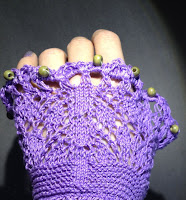 |
| Branching Out scarf in Bernat Baby yarn. It's my firstattempt at the BO pattern |
One change I made in the pattern is changing all double decreases, no matter if they're written as k3tog, sl2-k1-p2sso, or sl1-k2tog-psso, or however you make a 3stitch to 1stitch reduction. All my double decreases are centered double decreases, which I discovered when watching Annie Modesitt on TV explaining why to use them in her corset pattern. I then found out that a lot of lace shawl knitters use them to make the double decrease lace holes more defined.
 |
| Stole done in the Branching Out pattern. |
1. Slip the right one as if for knitting
2. Lift the left stitch over the middle stitch and drop it off the needle to catch on that middle stitch
3. Knit the middle stitch
4. And then slip that slipped stitch over the middle one that you just knitted, dropping it to catch on that middle stitch.
Basically, you're only knitting the middle stitch and dropping both outside stitches over it. With a yarnover on either side, it makes a nice, even lacey hole on either side of the double decrease, which I can't get doing it any other way.
 |
| Finished armstutzerl done in No. 10 cotto |
GARTER STITCH WRIST:
I started from the wrist down with 72 stitches on circular needles. Knit three panels of 21 stitches of garter stitch separated by 3 stocking stitch dividers (21+3+21+3+21+3) for 12 rows for a kind of bracelet effect.
LACE CUFF:
 |
| Lace cuff with crochet trim and wooden beads sewn on to keep the edge from curling. |
I did two repeats of the 10-row lace pattern, cabling the stocking stitch dividers every ninth row. Then I loosely cast off three stitches at a time with a crochet hook, and added a simple crocheted trim across the knuckles. I had some little wooden beads, so I sewed them on to keep the edge from curling up. Glass or ceramic would have been a little heavier, but I didn't have any. I could alternatively have crocheted more trim on to keep it from curling, but didn't want to take the cuffs past the knuckles.
ARM/SLEEVE SECTION:
 |
| Jamie's arm in her armstutzerl. |
TOP:
Knit a K1P1 pattern until it's up to the bend of your elbow - or long enough to suit you - then use a really stretchy cast off. There are some videos on Youtube that show different ones, so pick whichever one you're most comfortable with.
I'm 55 years old and have little occasion for lacy armstutzerl, so I had my niece Jamie, who hand blends and sells specialized makeup, in mind the entire time I was knitting these. I recently surprised her with them in her mailbox and am glad to report that she is delighted. As a matter of fact, the photos on here of the armstutzerl were taken by her after she painted her nails to match. I'm a happy aunt.
For a PDF armstutzerl pattern based on a 16th century Bavarian portrait, click here.
